Marcel Duchamp (1887 – 1968)
Get a Duchamp Certificate of Authenticity for your painting or a COA for your Boucher drawing or print.
For all your Duchamp artworks you need a Certificate of Authenticity in order to sell, to insure or to donate for a tax deduction.
How to get a Duchamp Certificate of Authenticity is easy. Just send us photos and dimensions and tell us what you know about the origin or history of your Duchamp painting, drawing or print.
If you want to sell your Duchamp painting, drawing or print use our selling services. We offer Duchamp selling help, selling advice, private treaty sales and full brokerage.
We have been authenticating Duchamp and issuing certificates of authenticity since 2002. We are recognized Duchamp experts and Duchamp certified appraisers. We issue COAs and appraisals for all Duchamp artworks.
Our Duchamp paintings, drawings and print authentications are accepted and respected worlwide.
Each COA is backed by in-depth research and analysis authentication reports.
The Duchamp certificates of authenticity we issue are based on solid, reliable and fully referenced art investigations, authentication research, analytical work and forensic studies.
We are available to examine your Duchamp painting, drawing or print anywhere in the world.
You will generally receive your certificates of authenticity and authentication report within two weeks. Some complicated cases with difficult to research Duchamp paintings or drawings take longer.
Our clients include Duchamp collectors, investors, tax authorities, insurance adjusters, appraisers, valuers, auctioneers, Federal agencies and many law firms.
We perform Marcel Duchamp art authentication, appraisal, certificates of authenticity (COA), analysis, research, scientific tests, full art authentications. We will help you sell your Marcel Duchamp or we will sell it for you.

1911 Oil on canvas 28 3/4 x 23 5/8 inches (73 x 60 cm)
Solomon R. Guggenheim Museum, New York
![Duchamp, Nude (Study), Sad Young Man on a Train (Nu [esquisse]](uploads/artists/artists_a-k/duchamp/2.duchamp.jpg)
1911–12 Oil on cardboard, mounted on Masonite 39 3/8 x 28 3/4 inches (100 x 73 cm)
The Solomon R. Guggenheim Foundation, Peggy Guggenheim Collection, Venice
Marcel Duchamp was a French-born artist, who redefined modern art in the post World War I era. While Duchamp is often associated with the Surrealist and Dadaist movements, his work remains in a league of its own. Duchamp challenged the way people think about art and artistic practices. While Duchamp did not produce a large quantity of works, the pieces he did produce were often controversial and avant-garde.

1911 Brown ink with watercolor wash on writing paper 8 3/8 x 7 1/4 inches (21.2 x 18.4 cm)
Solomon R. Guggenheim Museum, New York
Duchamp was born in the Haute-Normandie region of France. Duchamp’s siblings Jacques Villon, Raymond Duchamp-Villon and Suzanne Duchamp-Crotti were also active artists. As a child, Duchamp drew and painted alongside his older siblings.
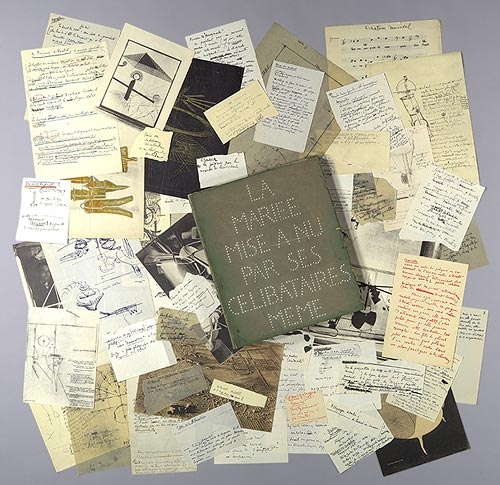
1934 Box containing collotype reproductions on various papers
Overall: 13 x 11 1/8 x 1 in. (33 x 28.3 x 2.5 cm)
From 1904 to 1905 Duchamp studied at the Académie Julian in Paris. After only a year of study, Duchamp was obligated to join the army, where he worked as a printer. As a printer Duchamp was able to learn about printing processes and typography.
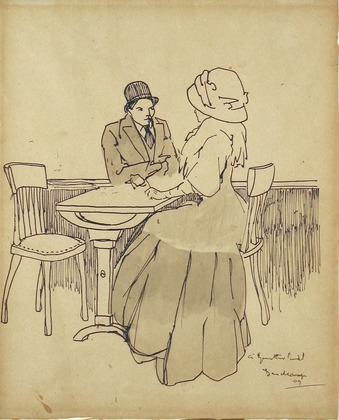
1909 Pen and ink and wash on paper 12 x 9 7/8″ (30.5 x 25.7 cm)
In 1908-09 Duchamp exhibited his work in both the Salon d’Automne and the Salon des Indépendants. Duchamp soon became acquainted with a circle of like-minded artists including Picabia, Robert Delaunay, Fernand Léger, Roger de la Fresnaye, Albert Gleizes, Jean Metzinger, Juan Gris and Alexander Archipenko. The group, hosted by Duchamp’s brother, Jacques, was known as the Puteaux Group or Orphic Cubists.
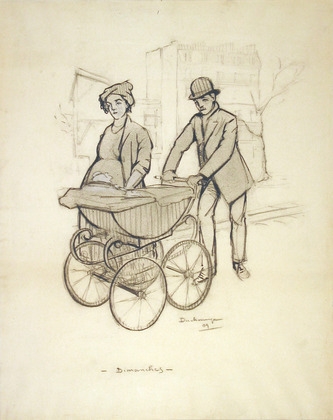
1909 Conté crayon, ink, and gouache on paper 24 x 19 1/8″ (61 x 48.5 cm)

1911 Oil on canvas 18 1/8 x 24″ (46.3 x 61.3 cm)
Duchamp’s first controversial work was ‘Nude Descending a Staircase, No. 2’. Duchamp gradually moved away from Cubist theory and started exploring the ‘fourth dimension’. In 1913 Duchamp entered the Armory Show in New York City, known as the International Exhibition of Modern Art, where he continued to stir the minds of critics and spectators.
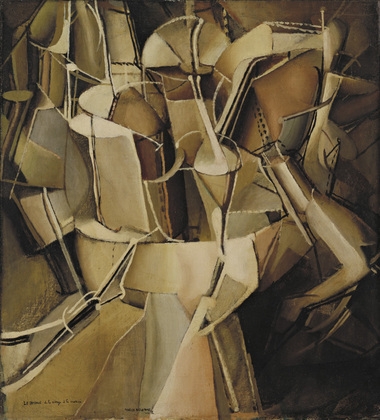
1912 Oil on canvas, 23 3/8 x 21 1/4″ /59.4 x 54 cm
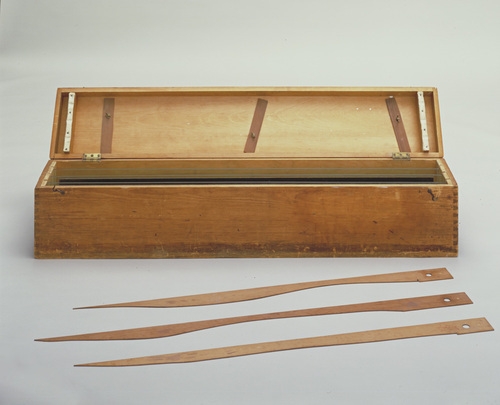
1913-14 Wood box 11 1/8 x 50 7/8 x 9″ (28.2 x 129.2 x 22.7 cm) three threads 39 3/8″ (100 cm), glued to three painted canvas strips 5 1/4 x 47 1/4″ (13.3 x 120 cm)

1951 (Third version, after lost original of 1913) Metal wheel mounted on painted wood stool, 51 x 25 x 16 1/2″ (129.5 x 63.5 x 41.9 cm)
After 1913 Duchamp created few traditional paintings and devoted his attention to technical drawings. Duchamp became less engaged with academic painters and spent his time working in a library and studying math and science.
In 1915, a year after the start of World War I, Duchamp made the decision to leave Paris and emigrate to the United States. Duchamp settled in New York, where he quickly met artists and art patrons.
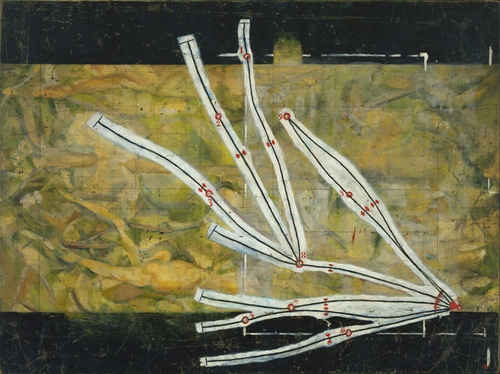
1914 Oil and pencil on canvas 58 5/8″ x 6′ 5 5/8″ (148.9 x 197.7 cm)

1918 Oil, silver leaf, lead wire, and magnifying lens on glass (cracked), mounted between panes of glass in a standing metal frame, 20 1/8 x 16 1/4 x 1 1/2″ (51 x 41.2 x 3.7 cm)
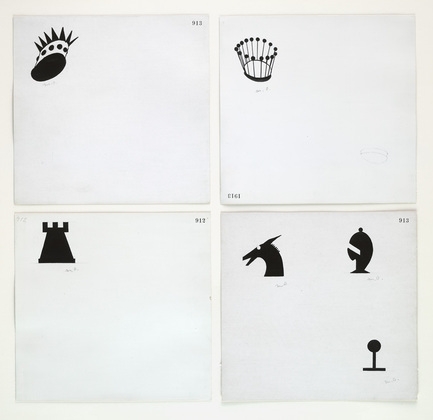
1920 Ink, pencil, and relief printing on paper, 8 5/8 x 9″ (21.9 x 22.9 cm) each
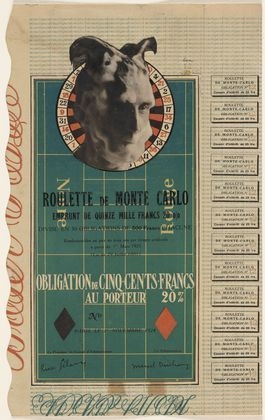
1924 Cut-and-pasted gelatin silver prints on lithograph with letterpress, 12 1/4 x 7 1/2″ (31.2 x 19.3 cm)
By 1920 Duchamp formed the Société Anonyme with Katherine Dreier and Man Ray. The group was able to bring European Dadaist ideas to New York. The group discussed ‘ready-mades’ and ‘found’ art, among other things.
Duchamp made his most controversial move by submitting his most iconic piece; a urinal coined ‘Fountain’, to the Society of Independent Artists. His submission outraged fellow Dadaists. Despite criticism, Duchamp continued to work and published a Dada magazine in New York known as The Blind Man.
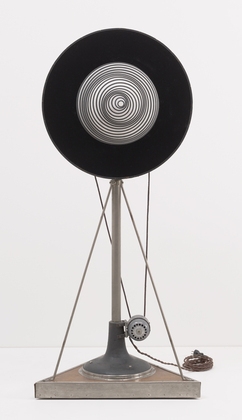
1925 Painted papier-mâché demisphere fitted on velvet-covered disk, copper collar with plexiglass dome, motor, pulley, and metal stand, 58 1/2 x 25 1/4 x 24″ (148.6 x 64.2 x 60.9 cm)

1912 Oil on canvas 57 7/8″ x 35 1/8″
Philadelphia Museum of Art
In 1918 Duchamp took a break from his main artwork ‘Large Glass’ and travelled to Argentina. In Argentina Duchamp focused on playing chess, an exercise he compared to drawing.
In 1923, after the end of the war, Duchamp returned to Paris through the financial backing of Jacques Doucet. In Paris, Duchamp withdrew from Dadaism and began to make optical devices. The devices were known as Rotoreliefs and would spin around on a phonograph. The spinning designs were filmed and produced in 1926 as Anémic Cinéma.
While the Rotorelief project was not incredibly successful, Duchamp continued to play chess in France, as he thought is was more pure than art, which was easily commercialized and tainted.
Marcel Duchamp is now recognized for the tremendous impact he made on the art world. His pieces are in the most prestigious, international museums and collections. Do you think you own a piece by Marcel Duchamp? Contact us. We are the experts on Marcel Duchamp.
Reviews
1,217 global ratings
5 Star
4 Star
3 Star
2 Star
1 Star
Your evaluation is very important to us. Thank you.
